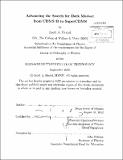Advancing the search for dark matter : from CDMS II to SuperCDMS
Author(s)
Hertel, Scott A. (Scott Alexander)
DownloadFull printable version (48.53Mb)
Other Contributors
Massachusetts Institute of Technology. Department of Physics.
Advisor
Enectali Figueroa-Feliciano.
Terms of use
Metadata
Show full item recordAbstract
An overwhelming proportion of the universe (83% by mass) is composed of particles we know next to nothing about. Detecting these dark matter particles directly, through hypothesized weak-force-mediated recoils with nuclear targets here on earth, could shed light on what these particles are, how they relate to the standard model, and how the standard model fits within a more fundamental understanding. This thesis describes two such experimental efforts: CDMS 11 (2007-2009) and SuperCDMS Soudan (ongoing). The general abilities and sensitivities of both experiments are laid out, placing a special emphasis on the detector technology, and how this technology has evolved from the first to the second experiment. Some topics on which I spent significant efforts are described here only in overview (in particular the details of the CDMS II analysis, which has been laid out many times before), and some topics which are not described elsewhere are given a somewhat deeper treatment. In particular, this thesis is hopefully a good reference for those interested in the annual modulation limits placed on the low-energy portion of the CDMS II exposure, the design of the detectors for SuperCDMS Soudan, and an overview of the extremely informative data these detectors produce. It is an exciting time. The technology I've had the honor to work on the past few years provides a wealth of information about each event, more so than any other direct detection experiment, and we are still learning how to optimally use all this information. Initial tests from the surface and now underground suggest this technology has the background rejection abilities necessary for a planned 200kg experiment or even ton-scale experiment, putting us on the threshold of probing parameter space orders of magnitude from where the field currently stands.
Description
Thesis (Ph. D.)--Massachusetts Institute of Technology, Dept. of Physics, 2012. Cataloged from PDF version of thesis. Includes bibliographical references (p. 285-294).
Date issued
2012Department
Massachusetts Institute of Technology. Department of PhysicsPublisher
Massachusetts Institute of Technology
Keywords
Physics.